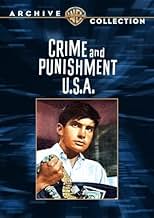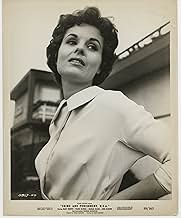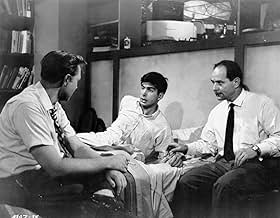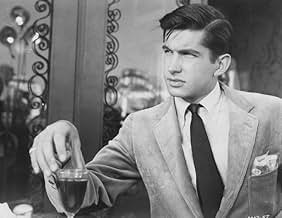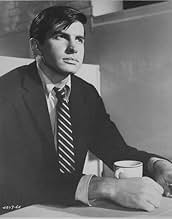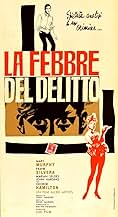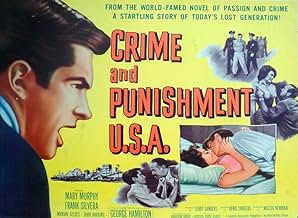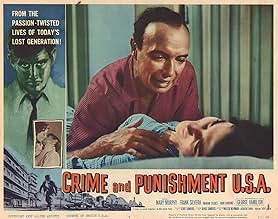अपनी भाषा में प्लॉट जोड़ेंA Californian law student murders a pawnbroker, then matches wits with the detective on the case.A Californian law student murders a pawnbroker, then matches wits with the detective on the case.A Californian law student murders a pawnbroker, then matches wits with the detective on the case.
- 1 BAFTA अवार्ड के लिए नामांकित
- 2 जीत और कुल 1 नामांकन
Tony Johnson
- Mrs. Cole
- (as Toni Merrill)
Sidney Clute
- Doctor
- (as Sid Clute)
James Hyland
- Man in Coffee Shop
- (as Jim Hyland)
फ़ीचर्ड समीक्षाएं
In California, Robert Cole (George Hamilton) collapses in front of the cops. He buries the evidence of his crime, but a dying man may have seen him. He takes the man back home to Sally. He had written an article stating that certain superior people can break the law which comes to the notice of the police. He is brought in for an interview.
This opens on Pacific Ocean Park in Santa Monica. The most fascinating part of this B-crime movie may be the locations. It's great to see the old California with all the oil rigs. It does have a young George Hamilton as the lead. He's fine, but he's never been a great actor. I wanted this to start as a darker noir crime thriller. Robert should leave the man to die on the side of the road. That's the darker start. It's interesting that Robert has his views. Otherwise, the plot drags and I don't really care about him. This is not as compelling as it should be.
This opens on Pacific Ocean Park in Santa Monica. The most fascinating part of this B-crime movie may be the locations. It's great to see the old California with all the oil rigs. It does have a young George Hamilton as the lead. He's fine, but he's never been a great actor. I wanted this to start as a darker noir crime thriller. Robert should leave the man to die on the side of the road. That's the darker start. It's interesting that Robert has his views. Otherwise, the plot drags and I don't really care about him. This is not as compelling as it should be.
George Hamilton stars with Marian Seldes and Mary Murphy in "Crime and Punishment USA," an adaptation of the novel by Dostoevsky, directed by Denis Sanders.
The film "introduces" George Hamilton.
Hamilton plays a young man who kills and robs a pawnbroker and later comes up against a smart police detective (Frank Silvera) who preys on his conscience.
The only other version of this I've seen is the Peter Lorre one from 1935 and as you might guess, this film doesn't compare, and comparing George Hamilton to Peter Lorre - well, it can't be done.
One thing both films have in common is that they were done cheaply, and both in black and white. The black and white serves both films very well. It made the places in this film look kind of low-class and gritty.
The atmosphere was really the only thing I liked. The music was very loud and had those screeching trumpets one always heard in the '50s and '60s in films.
I also thought everyone acted somewhat inappropriately. It's possible it all happened in the other film, but it was either done better or I just don't recall it.
When a man admits to killing someone, what would make a woman suddenly decide she wants to sleep with him? Especially after an uncomfortable scene where he yelled at her and acted rather weirdly.
Hamilton would be talking and suddenly start shouting -- it seemed like the emotions in this film came on suddenly with no build-up.
It was interesting to see such a young Marian Seldes as Hamilton's sister. She was a stage actress and teacher, married at one time to Garson Kanin. She died last year.
I saw George Hamilton in "La Cage aux Folles" a few years ago. He's done a great job of marketing his personality, and he obviously has a sense of humor, but he didn't register much, and he co-starred with an excellent Broadway performer, which made him look worse. I don't think in films he was a horrible actor, just not that great.
So that's Crime and Punishment U. S. A.
The film "introduces" George Hamilton.
Hamilton plays a young man who kills and robs a pawnbroker and later comes up against a smart police detective (Frank Silvera) who preys on his conscience.
The only other version of this I've seen is the Peter Lorre one from 1935 and as you might guess, this film doesn't compare, and comparing George Hamilton to Peter Lorre - well, it can't be done.
One thing both films have in common is that they were done cheaply, and both in black and white. The black and white serves both films very well. It made the places in this film look kind of low-class and gritty.
The atmosphere was really the only thing I liked. The music was very loud and had those screeching trumpets one always heard in the '50s and '60s in films.
I also thought everyone acted somewhat inappropriately. It's possible it all happened in the other film, but it was either done better or I just don't recall it.
When a man admits to killing someone, what would make a woman suddenly decide she wants to sleep with him? Especially after an uncomfortable scene where he yelled at her and acted rather weirdly.
Hamilton would be talking and suddenly start shouting -- it seemed like the emotions in this film came on suddenly with no build-up.
It was interesting to see such a young Marian Seldes as Hamilton's sister. She was a stage actress and teacher, married at one time to Garson Kanin. She died last year.
I saw George Hamilton in "La Cage aux Folles" a few years ago. He's done a great job of marketing his personality, and he obviously has a sense of humor, but he didn't register much, and he co-starred with an excellent Broadway performer, which made him look worse. I don't think in films he was a horrible actor, just not that great.
So that's Crime and Punishment U. S. A.
This is a well written script based on Dostoyevsky's "Crime and Punishment." I think it is essentially a remake of a French film, with Jean Gabin,called "Crime and Punishment," later changed to "The Most Dangerous Sin," made around the same time. At any rate, self- justification, remorse, rationalization, guilt, and Truth are the subjects at hand. Each is handled slowly, without emphasis; the viewer is expected to bring much to the picture. This explains the films lower ratings. Hamilton, as an actor, is weak, others have been reminded of Tony Perkins. He was too handsome, and wasn't smart enough to use make up or a cheap haircut to make himself appear to be the poor student of his role. But, the real star is Frank Silvera, who underplays the cagey Detective, and is a joy to watch in action. He toys with Hamilton, who, unfortunately, just isn't his match (as an actor.) Marian Seldes plays Hamilton's long suffering sister.
This is a very good adaptation of Dostoevsky's novel. The actors all gave solid performances, and the script captures the essence of an investigation into a crime that will depend on not on physical evidence, or finding a witness, but on a psychological campaign by the police detective, as he seeks to get a crack his suspect. As George Hamilton's Robert fences with Frank Silvera's Inspector Porter, he tries to come to terms with his own guilt and fear. In the end, it resolves wonderfully, with Robert coming to terms with his actions and deciding how to live them.
The low budget for the film seems to have been a benefit in this case. The seedy Southern California landscapes give a feel of desperation that makes the initial crime believable, and makes Robert's desire to escape it understandable. And the 'cheapness' fits the small cast, and the film's concentration on a few characters, intensifying the psychological pressure Robert is feeling.
Really well done, and I highly recommend it.
The low budget for the film seems to have been a benefit in this case. The seedy Southern California landscapes give a feel of desperation that makes the initial crime believable, and makes Robert's desire to escape it understandable. And the 'cheapness' fits the small cast, and the film's concentration on a few characters, intensifying the psychological pressure Robert is feeling.
Really well done, and I highly recommend it.
"Crime & Punishment, USA" updates Fyodor Dostoevsky novel to the 20th century and transports it from Saint Petersburg to Los Angeles. It wasn't the first film to do so, with a 1956 French adaptation and, before that, the American "Fear" (1946) is a "Crime and Punishment" picture in all but name; plus, another 1959 reworking also from France, Robert Bresson's "Pickpocket," took even more liberties with the text that it's, nonetheless, clearly inspired by. I'm not opposed to loose reworkings in the transmutation from prose to picture; indeed, "Pickpocket" is my favorite Dostoevsky film. Especially for a poor production such as this American counterpart, updating and transporting a narrative in adaptation makes a lot of economic sense. Moreover, it may lead to some interesting reinterpretations of the source that make it more relatable to modern times. Asking a low-budget 1959 film to adequately transcribe, say, the criticism of Russian nihilism from Dostoevsky's 19th century is a tall order and equally so for a general 1959 audience to understand. This film acknowledges that; plus, at least, it's evident that the filmmakers comprehended Dostoyevsky's story. Cleverly, they replaced the radicalism of Dostoevsky's era with some from their own--the Beat Generation.
Like Dostoevsky's protagonist Raskolnikov, the film's Robert murders a pawnbroker based on his philosophizing about his own supposed superiority (including in an article he penned), thus allowing him to flaunt the law in pursuit of allegedly benefiting humanity at large. Both characters' beliefs are of the sort of atheistic and counter-cultural order mocked by the conservative Dostoevsky. Thus, we see Robert play the bongos and even tap on his coffee cup before that. He doesn't wear turtlenecks and a fedora like a stereotypical beatnik, but I sense he thinks he's hip smoking a pipe instead of cigarettes like any upstanding 1950s American would. He's also unconcerned when the picture's Sonya type, renamed "Sally," admits her sexual promiscuity, but is upset with her prostitution because it's a self-sacrificing act that goes against his hedonistic thinking. A young George Hamilton looks the part, too. And, to top it off, we get a jazzy score.
I also like what is done with the Svidrigaïlov character, renamed "Fred." He's more vital here to Robert's redemption, unintended as it may be, whereas Sonya's "hooker with a heart of gold" was the underlying force behind that of Raskolnikov. Fortunately, Fred isn't the usual movie heavy as his counterpart was in the 1935 American adaptation, either. In the book, I found him to be one of the more amusing characters, and so he is here. I'm less fond of what is done with Sally. She's also something of a beatnik--what with the book of non-traditional spirituality in her room. She even sleeps with Robert right after he confessed the murder to her. She initially suggests that he turn himself in, but as quickly gives up on the idea. As with other adaptations, time is also given to the inspector interrogating the murderer, which is fairly well done here, although the 1935 French version remains probably my favorite handling of this character dynamic.
Unfortunately, the poor production values also lead to this appearing largely as a filmed play, with characters mostly talking in cramped flats. We don't see too much of Robert's Los Angeles, and he only briefly mentions the sort of wandering throughout the city that Raskolnikov did to consume much of the novel's substantial length. We also don't see the murder. And some of the sound effects are poorly done. Nevertheless, it does that one important thing right in updating its source to the Beat Generation. It's far from the best but also far from the worst version of the book I've seen.
Like Dostoevsky's protagonist Raskolnikov, the film's Robert murders a pawnbroker based on his philosophizing about his own supposed superiority (including in an article he penned), thus allowing him to flaunt the law in pursuit of allegedly benefiting humanity at large. Both characters' beliefs are of the sort of atheistic and counter-cultural order mocked by the conservative Dostoevsky. Thus, we see Robert play the bongos and even tap on his coffee cup before that. He doesn't wear turtlenecks and a fedora like a stereotypical beatnik, but I sense he thinks he's hip smoking a pipe instead of cigarettes like any upstanding 1950s American would. He's also unconcerned when the picture's Sonya type, renamed "Sally," admits her sexual promiscuity, but is upset with her prostitution because it's a self-sacrificing act that goes against his hedonistic thinking. A young George Hamilton looks the part, too. And, to top it off, we get a jazzy score.
I also like what is done with the Svidrigaïlov character, renamed "Fred." He's more vital here to Robert's redemption, unintended as it may be, whereas Sonya's "hooker with a heart of gold" was the underlying force behind that of Raskolnikov. Fortunately, Fred isn't the usual movie heavy as his counterpart was in the 1935 American adaptation, either. In the book, I found him to be one of the more amusing characters, and so he is here. I'm less fond of what is done with Sally. She's also something of a beatnik--what with the book of non-traditional spirituality in her room. She even sleeps with Robert right after he confessed the murder to her. She initially suggests that he turn himself in, but as quickly gives up on the idea. As with other adaptations, time is also given to the inspector interrogating the murderer, which is fairly well done here, although the 1935 French version remains probably my favorite handling of this character dynamic.
Unfortunately, the poor production values also lead to this appearing largely as a filmed play, with characters mostly talking in cramped flats. We don't see too much of Robert's Los Angeles, and he only briefly mentions the sort of wandering throughout the city that Raskolnikov did to consume much of the novel's substantial length. We also don't see the murder. And some of the sound effects are poorly done. Nevertheless, it does that one important thing right in updating its source to the Beat Generation. It's far from the best but also far from the worst version of the book I've seen.
क्या आपको पता है
- ट्रिवियाThe opening aerial shots are of Pacific Ocean Park in Santa Monica, CA, a popular amusement park in the 1960s that has since closed down.
- कनेक्शनReferenced in Hollywood Mouth 3 (2018)
टॉप पसंद
रेटिंग देने के लिए साइन-इन करें और वैयक्तिकृत सुझावों के लिए वॉचलिस्ट करें
विवरण
- चलने की अवधि1 घंटा 36 मिनट
- रंग
- ध्वनि मिश्रण
इस पेज में योगदान दें
किसी बदलाव का सुझाव दें या अनुपलब्ध कॉन्टेंट जोड़ें


